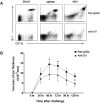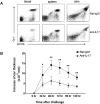Dermal γδ T Cells Do Not Freely Re-Circulate Out of Skin and Produce IL-17 to Promote Neutrophil Infiltration during Primary Contact Hypersensitivity
- PMID: 28081153
- PMCID: PMC5230790
- DOI: 10.1371/journal.pone.0169397
Dermal γδ T Cells Do Not Freely Re-Circulate Out of Skin and Produce IL-17 to Promote Neutrophil Infiltration during Primary Contact Hypersensitivity
Abstract
The role of mouse dermal γδ T cells in inflammatory skin disorders and host defense has been studied extensively. It is known that dendritic epidermal T cells (DETC) have a monomorphic γδ T cell receptor (TCR) and reside in murine epidermis from birth. We asked if dermal γδ cells freely re-circulated out of skin, or behaved more like dermal resident memory T cells (TRM) in mice. We found that, unlike epidermal γδ T cells (DETC), dermal γδ cells are not homogeneous with regard to TCR, express the tissue resident T cell markers CD69 and CD103, bear skin homing receptors, and produce IL-17 and IL-22. We created GFP+: GFP- parabiotic mice and found that dermal γδ T cells re-circulate very slowly-more rapidly than authentic αβ TCR TRM, but more slowly than the recently described dermal αβ TCR T migratory memory cells (TMM). Mice lacking the TCR δ gene (δ-/-) had a significant reduction of 2,4-dinitrofluorobenzene (DNFB)-induced contact hypersensitivity (CHS). We created mice deficient in dermal γδ T cells but not DETC, and these mice also showed a markedly reduced CHS response after DNFB challenge. The infiltration of effector T cells during CHS was not reduced in dermal γδ T cell-deficient mice; however, infiltration of Gr-1+CD11b+ neutrophils, as well as ear swelling, was reduced significantly. We next depleted Gr-1+ neutrophils in vivo, and demonstrated that neutrophils are required for ear swelling, the accepted metric for a CHS response. Depletion of IL-17-producing dermal Vγ4+ cells and neutralization of IL-17 in vivo, respectively, also led to a significantly reduced CHS response and diminished neutrophil infiltration. Our findings here suggest that dermal γδ T cells have an intermediate phenotype of T cell residence, and play an important role in primary CHS through producing IL-17 to promote neutrophil infiltration.
Conflict of interest statement
The authors have declared that no competing interests exist.
Figures









References
-
- Nanno M, Shiohara T, Yamamoto H, Kawakami K, Ishikawa H. gammadelta T cells: Firefighters or fire boosters in the front lines of inflammatory responses. Immunol Rev. 2007;215:103–113. - PubMed
MeSH terms
Substances
Grants and funding
LinkOut - more resources
Full Text Sources
Other Literature Sources
Molecular Biology Databases
Research Materials

